1st Medical Battalion Unit History

Troops of the 16th Infantry Regiment, 1st Division at “Rest” in the Company Street at Fort Devens, Ayer, Massachusetts.
Activation:
The 1st Medical Battalion was officially activated at Fort Devens, Ayer, Massachusetts (Reception Center for all recruits coming from New England; and Military Reservation; acreage 11,796; troop capacity 2,066 Officers and 33,232 Enlisted Men –ed) in October 1940, as the organic Medical Battalion for the 1st Infantry Division. Company B of the Battalion was activated a month later, with Company A contributing 15 Enlisted Men who had formerly been part of the 8th Medical Battalion as cadre. The remainder of Company B personnel was newly Enlisted Men from the New England area.
Training:
From November 1940 to January 1941, the unit trained its own men and other medical personnel of the Division. Training and maneuvers took place in the vicinity of Fort Devens until October 1941, when the Division moved to Samarcand, North Carolina for the October 1941-November 1941 First Army Carolinas Maneuvers. The day before the Japanese attack on Pearl Harbor (7 December 1941), the Battalion returned to Fort Devens. Almost immediately after news reached the station of the American declaration of war, amphibious training was started. December 1941 and January 1942 found the Battalion at Virginia Beach as part of this training program, finally returning to Ft. Devens at the end of the month.
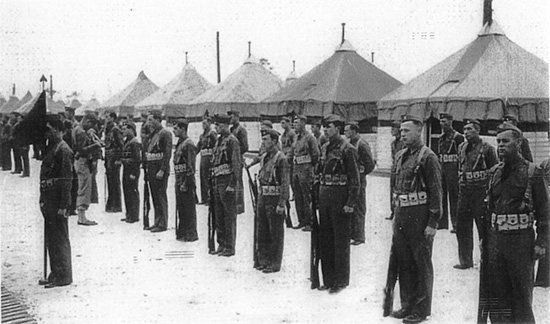
A Company formation of 16th Infantry Regiment, 1st Infantry Division during training exercises at Camp Blanding, Starke, Florida (Infantry Training Replacement Center –ed). Photo taken late February 1942.
On 10 February 1942, the 1st Division, including all organic units was ordered to Camp Blanding, Starke, Florida, as quickly as trains could be gathered and winter weather permitted, where it arrived on 21 February 1942. Following its arrival the Division was reorganized and refurbished with new equipment, being re-designated as the 1st Infantry Division on 15 May 1942. Within a week, this was 22 May, the entire organization was returned to Fort Benning, Colombus, Georgia for a demonstration maneuver showing air support of ground forces. From Ft. Benning, the Division was expedited on 21 June 1942 to Indiantown Gap Military Reservation, Pennsylvania (Staging Area for overseas departure and Training Center –ed). It was at this new station that the 1st Medical Battalion received replacements, clothing and equipment and in general prepared for its combat days ahead.
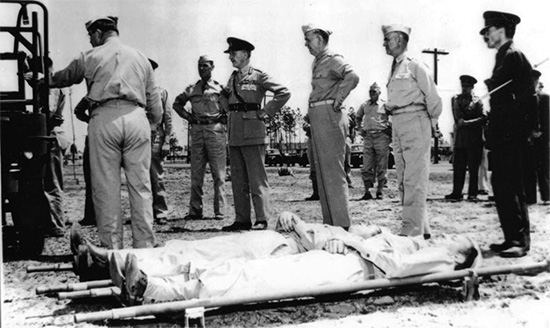
General George C. Marshall accompanied by Field Marshal Sir John Dill on his visit to the 1st Division. Here Captain Tegtmyer (later 18th Infanty Regimental Surgeon) explains the Regiment’s medical evacuation system to the Officers.
Preparation for Overseas Movement:
On 1 August 1942, the Battalion departed Indiantown Gap by truck to a railpoint near Harrisburg, and entrained for the New York Port of Embarkation. RMS Queen Mary was boarded at approximately 1200 the same day, and quarters for the 1st Medical Battalion were assigned on “E” Deck.
The vessel weighed anchor at approximately 1100 hours on 2 August 1942 for Scotland, United Kingdom.
United Kingdom:
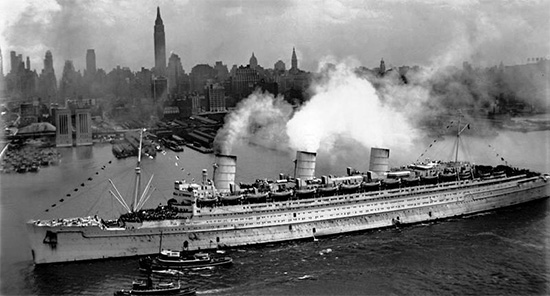
Exterior view of RMS Queen Mary which transported the 1st Medical Battalion (along with other elements of the 1st Infantry Division) to Scotland in August 1942.
After 5 days of uneventful voyaging, the ship entered the bay at Gourock, Scotland, and on the morning of 7 August 1942 the Battalion debarked and entrained for Tidworth Barracks, Wiltshire, England. The men had their first taste of British rations on the train, as cold meat pies and tea were passed out by a group of female workers. After about 20 hours aboard the train, the unit reached its destination at 0515 on 9 August. The next few days were spent in setting up camp, becoming familiar with English money, food and customs. After a week, an intensive training schedule was initiated with a particular emphasis on physical conditioning. A few passes were granted to travel to London and a Red Cross Cub was established on the post.
The first week of September 1942 found the Battalion packing and alerted for movement to Roseneath, Scotland. The mission was training in amphibious landings. The Battalion traveled in two groups, one by train and the other by motor convoy. Upon arrival, the unit joined the 18th Infantry Regiment for maneuvers. After a week, the 18th RCT moved down to the outskirts of Glasgow and in the vicinity of Corkerhill. The 1st Medical Battalion established a temporary field hospital in the area to service the Combat Team.
On 11 October, the Battalion was alerted for departure, and at 0900 hours the following day the greater part of Company A consisting of Company Headquarters and the Station Platoon, with some members of the other Platoons, entrained for Gourock where they arrived at 1200 hours, and boarded HMS Ettrick at 1400. The Company vehicles and their drivers traveled on other ships and thirteen Enlisted Men of the Litter Platoon traveled with each of the Battalion Aid Station outfits.
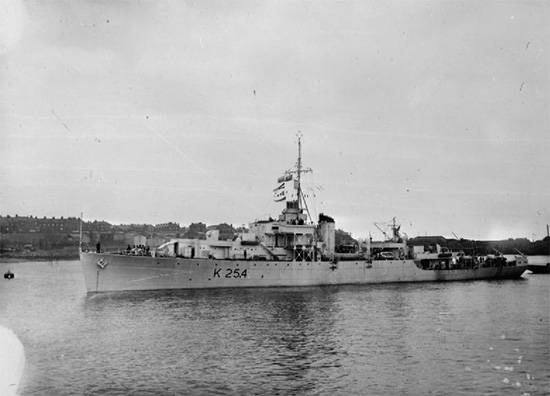
Exterior view of the River-class frigate HMS Ettrick which transported elements of the 1st Medical Battalion to North Africa.
While aboard HMS Ettrick, the 1st Med Bn operated the ship’s hospital, under the direction of Capt. Pearson and Lts. Merriman and Warres (of Company A). There were classes in first aid and calisthenics to keep the unit fighting fit. Vest haversacks, specially invented by Capt Tegtmeyer of Company B, for amphibious operations were packed with medical supplies to be carried ashore in the initial waves of the coming landings. The destination was unknown and the ship was flooded with rumors and guesses. The Ettrick pulled out of Gourock Harbor for a practice operation on the Scottish coast that lasted a day, and then returned to her berth to await the completion of the convoy. At 2100 hours on 26 October, the ship set sail for “Destination Unknown”.
The voyage lasted thirteen days during which period the nature of the mission was explained; to land in Algeria, North Africa and seize the port of Oran.
North Africa:
“Operation Torch” 8 November 1942
At 0700 hours on 8 November 1942, Company B, 1st Medical Battalion (part of Center Task Force under command of Maj. General Lloyd R. Fredendall –ed) debarked from the HMS Ettrick, boarded landing craft and landed on Z Beach Green, a mile east of Arzew, Algeria. The casualties on the beach were collected and moved to a civilian Hospital at Arzew by a group led by Capt. Tegtmeyer. Another group, led by Capt. Pearson proceeded directly inland to set up an Aid Station. At 1400 hours the temporary hospital was turned over to a Clearing Company, and the group marched 8 miles and set up a station one mile from Rennan on the road to Saint-Cloud, where the two groups joined. The station evacuated patients until 1800 hours on 10 November when the Battalion moved to Saint-Cloud and cleared casualties. At 0800 hours on 12 November, the unit moved once again, this time to Oggaz and immediately entered bivouac. From 12 November to 7 December, the Battalion rested and checked equipment and supplies. The Litter Bearers and Ambulance Drivers rejoined their respective Companies, but Ambulances were kept at the 18th Infantry Regiment Aid Stations to evacuate the wounded. On 28 November, Company B moved to the vicinity of Sainte-Barbe-du-Tlélat where it rejoined the remainder of the Battalion.

Members of the 1st Infantry Division storm Z Beach Green, a mile east of Arzew, Algeria, on 8 November 1942.
The first phase of the Tunisian Campaign started mid-November 1942 with a gradual commitment of American troops in support of the British First Army. On 7 December additional alert orders were received – the Battalion was to depart with the 18th Infantry Regiment to Tunisia. The move was completed by motor convoy, arriving at L’Arba, Algeria at 0800 hours on 9 December. 300 miles of the treacherous Atlas Mountains had been covered by day and night driving in cloudy weather. At this new location, 1st Platoon, Company B, 1st Engineer Battalion was attached to Company B, 1st Medical Battalion for rations and administration. 15 December found the convoy mobbing again, through Sétif, Constantine to Ghardimaou (little town in the northwestern part of Tunisia –ed), arriving 18 December 1942. After a short period of rest and recuperation, the final leg of the journey to Medjez el Bab, Tunisia was completed on 22 December.
An advance party of the Station Platoon (Company B) with Litter Bearers and Ambulance Drivers moved forward with 1st Battalion, 18th Infantry Regiment as part of the battle force that was to capture Longstop Hill. The attack started on Christmas Eve 1942, and lasted throughout the following day. After twice gaining the hill, the Infantry finally had to withdraw in the face of intense enemy fire.
1 January 1943 found the Battalion set up in the vicinity of Medjez el Bab in the mud, cold and rain, living under sporadic shelling and strafing by enemy aircraft. Members of Company B assisted the Engineers in repairing roads, and also helped to run the nearby British delousing unit for troops in the area. On 13 February, after a month and half on the line, the Battalion was pulled back to Téboursouk. After a few days rest the outfit was once again on the move towards Sbeïtla on 18 February 1943. A new station was established in a river bed and evacuation continued under difficult conditions. On 3 March, the Company area was strafed by enemy planes and two anti-aircraft guns were supplied for protection.
On 11 March, the unit pulled back with the 18th Infantry Regiment for reorganization at Bou Chebka and by 15 March was moved once again towards Fériana. For the days that followed, the outfit was in the vicinity of Gafsa and on 23 March the unit handled its heaviest casualties to date from the Battle of El Guettar. During the action, all Litter Bearers and Ambulance Drivers were attached to the Infantry Medical Detachment. The Station Platoon of Company B handled the numerous casualties smoothly and efficiently, working around the clock under hazardous conditions. In this action, three men were wounded: Pfc John J. Maloney and Pfc Chester A. Piascyk while guiding an ambulance through a minefield, and Pvt Russell H. Taylor, while evacuating casualties as a member of a Litter Squad. One Officer and seven Enlisted Men from Company B were awarded the Silver Star for their work during the action; they were as follows:
Capt. Tegtmeyer (Commanding Officer, Company B)
Pfc Paul C. Bailey
Pfc Harold B. Camden
Pfc Saverio Contorno
Pfc Harold S. Conlon
Pfc Hugh J. McCord
Pfc John J. Maloney
Pfc Lews E. Randall
In addition, Company B was specifically cited in Division General Orders, and the citation read in part:
“The speed and efficiency with which evacuations were effected greatly minimized the loss of life and contributed materially to the success of the combat team to which it was attached during this important operation.”
The Battalion moved back 145 miles for rest and reorganization at Djourou Khadra that lasted from 14 April to 17 April, and then it finally moved again to Bédja and participated in action around Bédja-Mateur from 19 April to 12 May 1943. The fighting was heavy and there were many casualties evacuated, but finally Mateur was taken and quickly the campaign in Tunisia was over. On 13 May, Company B started the long trek back to Oran, Algeria and on 17 May entered bivouac with the balance of the 1st Medical Battalion at Sidi Chami on the outskirts of Oran. There was a period of rest, all clothing and equipment was checked, and passes for recreation in Oran and other nearby towns were issued.
During the Algerian and Tunisian Campaigns, Company B alone had evacuated 3,250 sick and wounded over bad roads and under enemy fire. The Battalion was now a proud and seasoned unit.
The beginning of June 1943 saw the Battalion moving east with the 18th Infantry Regiment to the Forêt de la Macta, Algeria, where a training schedule was initiated including amphibious operations and evacuations. In the vicinity of Mers-El-Hadjadj, the Battalion participated in landing operations, and on 24 June the major part of the outfit, less reserve vehicles and drivers boarded LCIs (Landing Craft, Infantry –ed) and sailed up to the Bay of Tunis, arriving on 28 June. Immediately following debarkation, the unit entered bivouac in a staging area where it remained until 5 July 1943. On that date, the unit returned to the LCIs and the journey continued to Sousse, Tunisia, where the men disembarked and made a short march. Another vessel was boarded as part of a large convoy, and at 2345 on 8 July, the ship and other vessels set sail for the next destination: Gela, Sicily.
Sicily:
“Operation Husky” 10 July 1943
Following an intensive period of training at the Fifth United States Training Center at Arzew, Algeria, the 1st Infantry Division was instructed to join the troops participating in the assault phase of the operation (part of the Dime Force to land near Gela, Sicily –ed). The convoy of ships arrived off the Sicilian coast on 10 July 1943. The following day, the Battalion landed on the beach in the vicinity of Gela, Sicily, against light opposition, and set up a Clearing Station in support of the 26th RCT. Following debarkation, the various groups from the LCIs joined and moved inland four miles, gradually sweeping over western and central Sicily. On 12 July, a Jeep and two Ambulances came ashore and joined the unit. Three Ambulances aboard a vehicle transport were lost when the ship was sunk by the Luftwaffe.
The Battalion started to move across Sicily in quick order; Mazzarino, Palazzo Marino, Caltanissetta, Villarosa, Gaia, Gangi, Nicosia , Cerami and Troina. At Troina the reserve vehicles joined Company B on 12 August. There was bitter fighting around Troina situated on top of a rocky hill with the Litter Bearers making long and difficult carries. For his gallantry in leading the Litter Bearers in their evacuation, S/Sgt Jack Pingree was awarded the Silver Star.
The battle for Troina over, the outfit moved forward to Randazzo and then to Mojo, where they were established when the campaign ended. On 13 August, Capt. Tegtmeye vacated his role as Commanding Officer, Company B, to become Regimental Surgeon with the 18th Infantry Regiment, with Capt. James C. Brown assuming command of Company B.
It is important to note that while operating on Sicily, American medical personnel encountered some unknown varieties of subtropical diseases which had to be dealt with. The island harbored flies, fleas, lice, and mosquitoes, and as sanitation was not a priority for the local population, dysentery and most of all malaria were constant threats. Preventive measures beginning in April of 1943 proved effective, except for malaria, and although recommended and widely issued, all troops did not take the required Atabrine, resulting in numerous cases. In August of 1943, malaria figures were higher than battle casualties!
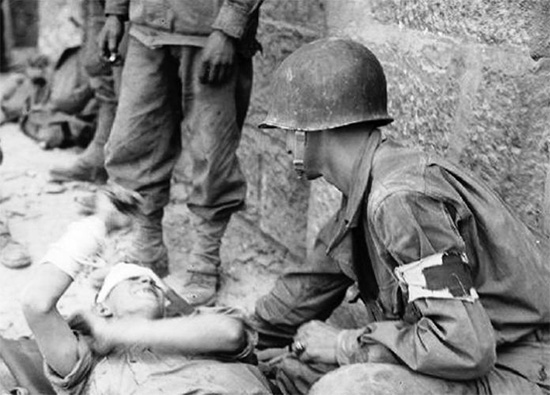
An Aidman of the Medical Detachment, 16th Infantry Regiment treats a wounded German prisoner during fighting in Sicily.
With the campaign over, on 20 August 1943 the Battalion moved 167 miles and bivouacked at Palma, in the vicinity of Licata. A light training and recreation program was initiated with swimming, softball, movies and stage shows. The unit remained in bivouac at Palma until 20 October. During this time, Capt. Carl W. Hammer assumed command of Company B, with Capt. Brown leaving for another unit in the area. Training and recreation continued, and on 18 September there was a command inspection by the Division Commander.
Camp was broken on 20 October and preparations were made to move to August, Sicily. At 0415 hours on 21 October the Battalion left Palma in trucks and traveled 130 miles. At 1730, Company B left the staging area and at 2045 hours the Battalion boarded HMS Maloja. The men were assigned quarters and usual ship’s duties began. On 23 October at 1130 hours the ship departed her berth and set sail for England – the Mediterranean Theater of Operations was left behind.
United Kingdom:
In line with overall Allied strategy the build up in the United Kingdom for the planned cross-Channel attack against the European continent started to take some precedence over operations in the Mediterranean. Resulting from this strategy, veteran Divisions such as the 1st Infantry – 9th Infantry – 2d Armored – and most of the 82d Airborne Divisions were diverted from the Mediterranean Theater and ordered to England. The voyage from Sicily lasted 14 days, with a 2-day stopover at the Port of Algiers, Algeria. At 0400 hours on 5 November 1943, the ship arrived at Liverpool, England and docked at Mersey Docks at 1000 hours. The unit debarked the following morning at 0430, marched to the nearby railway station and boarded a train at 0630, departing the station at 0715, arriving in Maiden Newton, Dorset, England at 1700. From 7 to 14 November, the camp was organized, clothing and equipment were checked, new vehicles were drawn and a light training schedule started. With the return to England came a new Table of Organization; Company strength was cut by four men.
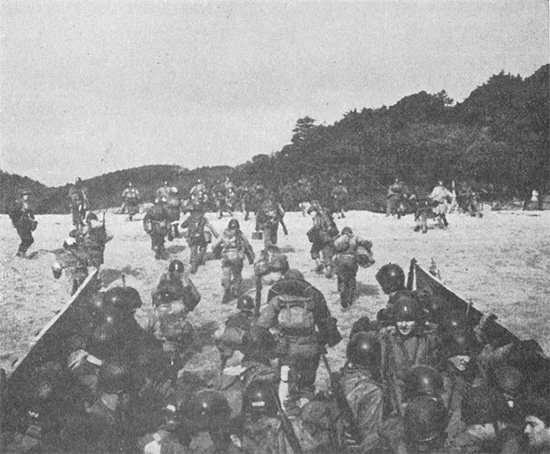
Members of the 1st Infantry Division exit a landing craft during Exercise “Tiger”, an amphibious training operation at Slapton Sands, Devon.
On 15 November the Battalion moved to a new camp at Piddlehinton Barracks, Dorchester, Dorset. Upon arrival, the camp was once again tidied and prepared for a longer stay, and reorganization under the new Table of Organization continued. The Battalion remained at Piddlehinton Barracks through the remainder of November and December 1943, until 11 January 1944. During this period a rigorous training schedule was put into effect with calisthenics, drill, road marches, classes, organized athletics, inspections and night exercises. Passes and furloughs were distributed and recreational convoys left nightly for nearby towns.
On 12 January 1944 the Battalion moved 14 miles to Cattistock, Dorset and organized a new camp. Training continued and tactical exercises were added to the program. Dorchester and Weymouth were the recreational centers for the men. On 16 January the Battalion attended an inspection by General B. L. Montgomery at Bridport, Dorset.
The Battalion remained at Cattistock through February, March and most of April. On 24 April the Battalion was alerted for departure. The unit split into four groups for the landing exercises at Slapton Sands, Devon that lasted through to 6 May 1944. On 7 May, the Battalion returned to Cattistock where equipment was checked and critique of the exercises was held. From 8 to 15 May there were small unit and Platoon problems to correct errors of exercises in accordance with this critique. On 15 May, the Battalion moved from Cattistock to Broadmayne, Dorset, representing a distance of only 12 miles. At this new station, each Company of the Battalion was split into eight groups: two station groups, two vehicle groups, two reserve vehicle groups and two litter squads each attached to the respective Infantry Regiments. From 16 to 27 May, the Battalion remained at Broadmayne. Assault Gas Masks were issued and tested in gas chambers on 22 May, and all Officers and Noncommissioned Officers were briefed between 23 and 26 May regarding the next operation for the 1st Infantry Division – the invasion of mainland Europe.
Allied invasion currency was issued on 24 May in French Francs, and 15 replacements joined the following day to bring the organization up to the allotted T/O strength. On 28 May the groups moved to their separate staging areas, arriving the same day. The briefing continued and all men were thoroughly instructed in the coming operation. Rations, cigarettes and other field items were issued on 31 May, and on 1 June all but the reserve vehicle groups boarded their respective ships at Portland Harbor, Portland and remained aboard ship until 1645 hours on 5 June 1944, when the vessels left their berths for Omaha Beach, Normandy, France.
France:
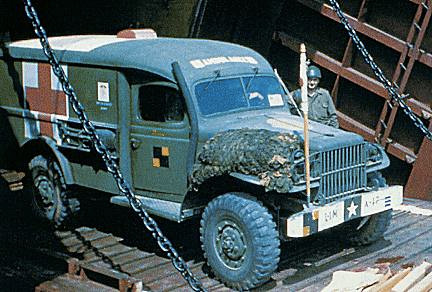
An WC-54 Ambulance of Company A, 1st Medical Battalion exits the hull of a landing craft off the shore of Omaha Beach. Photograph taken June 1944.
“Operation Overlord” 6 June 1944
The 1st Infantry Division (part of O Force under command of Maj. General Leonard T. Gerow –ed) had been attached to V Army Corps and was to land on Omaha Beach, Normandy. Company B, under the command of Capt. Merriam left their ship and boarded an LCI at 0900 hours on 6 June 1944, transferring to LCVPs at 1300 hours and landing at Easy Red, Omaha Beach at 1345 the same date under heavy artillery fire. After treating the wounded on the beach for approximately one hour, the group proceeded to the bluffs and established a temporary Aid Station to treat the wounded. A second group (largely comprising of Litter Platoons from Company B, commanded by Lt. Gaimari) had boarded an LCT at 1100, but was laid about two miles off shore for several hours; it finally landed at 1730. After the beach had been secured, all wounded were evacuated to the station at the top of the beachhead and the casualties were treated by the Battalion until about 2000 hours.
In the hours that followed, the Litter Squads landed with the Battalion Aid Station outfits, while the vehicle and reserve vehicle groups still remained off shore.
For outstanding work and gallantry in action during D-Day the following men of Company B were awarded the Silver Star:
S/Sgt Walter A. Sherman
S/Sgt Grover L. Whitehurst
T/3 Albert H. McFarland
Pfc Robert G. Galer
Pvt Adolph A. Allmoslecher
Pvt Joseph T. Chiofolo
Pvt James S. Frost
Pvt Real L. Lagasse
Pvt James P. Lenihan
Pvt Lawrence F. Lewis
Pvt Thomas F. Jones
Pvt John E. Lynch
Pvt Robert Winchester
Pvt John Mancinho
As well as the following Bronze Star awards:
Capt Philip G. Merriam
2d Lt Joseph Goprniak Jr.
T/3 Allen N. Towne
Sgt Saul Miller
Cpl Frank Fawcett
Pvt Herald E. Vose
All of the above awards were given for work in treating and evacuating the numerous casualties on the beach under heavy enemy fire.
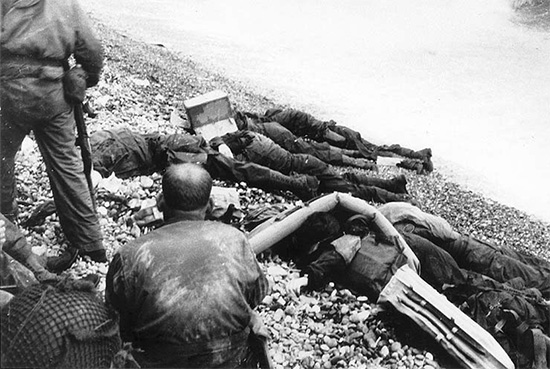
Photograph showing KIA troops of 3d Battalion, 18th Infantry Regiment on Omaha Beach the morning of D-Day, 6 June 1944.
On 7 June the Battalion moved about two miles inland to a new position in the vicinity of Colleville-sur-Mer where it established a temporary station. Six Ambulances and two Jeeps joined at 1700 hours, and there was little enemy activity in the immediate area. On 8 June two more Ambulances and one Dodge Weapons Carrier with water trailer joined the Battalion as it moved to Surrain. The following day, two more Ambulances joined the unit and each Company of the Battalion was now completely assembled. Seventeen (17) replacements joined during the period from 15 to 18 June and the unit moved to Le Tronquay, Balleroy and finally Cormolain. The outfit remained in Cormolain until 7 July during which time there was intermittent enemy artillery landing in the area.
Towards the end of June the activity became markedly increased. Enemy aircraft were regularly strafing the area, with bombs and artillery shells landing in nearby anti-aircraft and artillery unit areas. One night under an extremely severe shelling, Lt. Gaimari and a group of men from Company B went out to treat and evacuate the wounded from an anti-aircraft unit. For their exceptional work and heroism, the following men were decorated with the Bronze Star:
T/3 Allen N. Townes
Cpl Frank Fawcett
Pvt Alfred P. Hennet
Pvt Bernard L. Hurlhurst
Pvt James S. Frost
Pvt William R. Davis
Pvt John J. Fanale
Pvt James S. Chrisafis
Lt. Gaimari was awarded the Silver Star for the same action
On 1 July, Company B received a Letter of Commendation for medical services rendered from the Commanding Officer of the 62d Armored Field Artillery Battalion.
The period from 8 to 13 July was spent at Planquery with the station in operation and evacuation proceeding smoothly. On 14 July the unit was pulled back to Triqueville for a brief period of R&R, with relief being provided by a Collecting Company of the 5th Infantry Division. The unit rested and checked clothing, equipment and vehicles. Movies and showers were also provided to improve an already-low morale.
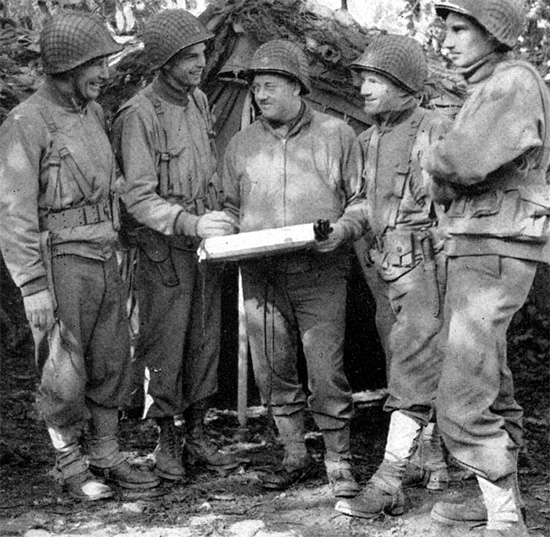
Colonel George A. Taylor, 16th Infantry Regiment Commanding Officer; Major Carl W. Plitt, S-3; Major Charles E. Tegtmeyer. Regimental Surgeon; Major John H. Lauten, S-2; and Captain William Friedman, S-1. Photo taken during amphibious exercises in England, early 1944.
On 15 July 1944, elements of Company B, 1st Med Bn moved to Haut-Vernay in preparation for the breakout of Saint-Lô, with all Litter Bearers being sent to the numerous Battalion Aid Station outfits. Les Champs-de-Losque, Montreuil-l’Argillé and La Barberie were used briefly as CPs through the end of July. On 30 July during a move from La Barberie to Saint-Denis-le-Gast, Pvt James P. Lenhian of Company B captured three enemy paratroopers.
At approximately 2300 hours on 31 July at Saint-Denis-le-Gast, enemy bombers appeared over the Company area and dropped numerous anti-personnel bombs wounding one Officer and 13 Enlisted Men, and setting fire to a Weapons Carrier. T/5 Stanley A. Marcavage extinguished the fire during the height of the attack and this action earned him the Silver Star. The Litter Platoon and other members of Company B evacuated wounded personnel from a nearby Tank Destroyer Battalion.
The Battalion was on the move in the action to close the Falaise Pocket, and from 1 to 12 August Le Mesnil-Garnier, Brécy, La Chevalée and Ambrières-les-Vallées were used as CPs. During the move from La Chevalée to Ambrières-les-Vallées, the Litter Platoon of Company B moved after the balance of the Company, and in the vicinity of Mortain, the vehicles transporting the personnel were fired upon by an enemy patrol. Although the men in the trucks were wearing Geneva Convention Brassards on their arms the enemy nevertheless threw several concussion grenades into and around the vehicles and cut loose with machine pistol fire, killing two men, wounding one Officer and six Enlisted Men. 2d Lt. Gorniak and Sgt Hogan managed to evacuate the wounded and the vehicles, and withdrew to a place of safety. A nearby Infantry unit was notified of the presence of enemy. Following the incident, the wounded were evacuated to the nearby Battalion Aid Stations, and the Platoon reformed. In spite of a severe eye injury, 2d Lt. Gorniak refused to be evacuated and took charge of the convoy, re-routing several times until he found the remainder of Company B. The casualties were as follows:
Pvt Adolph. A. Allmoslecher
Pvt Carl W. Eleholz
Pvt John J. Fanale (KIA)
Pfc Roy E. Gibson
2d Lt Joseph Gorniak, Jr.
Sgt Ralph J. Hogan
T/5 Lewis E. Randall
Pvt Archie Watkins
Pvt Robert Winchester
For his courage and outstanding leadership and heroism, 2d Lt Gorniak was awarded the Distinguished Service Cross.
The Battalion kept moving and new stations were established at La Sorrière and La Chapelle-Moche for one-day stops. On 15 August, the unit moved into Saint-Michel-des-Andaines during which period the men were given a chance to clean up and rest. There were movies and a nearby Red Cross Clubmobile was established.
The rest period was short-lived however, when on 24 August the unit travelled 110 miles to Courville-sur-Eure, and a further 70 miles the following day to Cerny. At 1530 hours on 27 August the Seine River was crossed with the Litter Platoons marching 25 miles. There was a new location each day; Gretz-Armainvilliers, Boutigny, Brumetz, Bucy-le-Long, Laon, Toulis-et-Attencourt, Leschelle and finally Malgarni for action around Mons, Belgium. Upon arrival at Malgarni, the unit was flooded with enemy wounded for three days with all types of vehicles being used for evacuation. American casualties were, however, relatively light.
The unit remained at Malgarni until the beginning of September, when orders arrived moving the unit, along with its parent organization into Belgium.
Belgium:
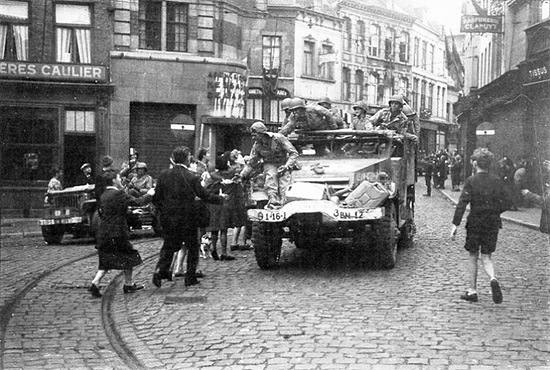
A 16th Infantry Regiment Halftrack and other vehicles from the 3d Battalion arrive in Mons, Belgium, in early September 1944.
On 6 September, the unit departed Malgarni into Belgium, with almost daily moves. The following 9 days saw the unit travel east through Belgium, stopping for minimal bivouac periods at Loverval, Namur, Saint-Georges-sur-Meuse, Herve, Aubel and Montzen. Finally, on 17 September the unit arrived at Hergenrath and immediately entered bivouac in an area approximately 5 miles from Aachen. Litter Bearers and Ambulance Drivers were already in Germany as the Battle of Aachen began. During the first days of operation, seven men from Company B were wounded; here follow their names:
Pvt Clifford G. Carten
T/4 Frank Fawcett
Pvt Alfred R. Gagne
Pvt John Mancinho
Sgt Marcus R. Nixon
Pvt Herald E. Vose
Pvt Ezra K. Waldrop
The Battalion remained at Hergenrath until 7 October 1944. The men were issued winter clothing and there were movies and hot showers. The station was in operation and evacuation proceeded smoothly. On 8 October it was announced that the unit would cease operations in Belgium and orders were issued to prepare all men and equipment for a crossing of the Rhine, into Germany.
Germany:
On 8 October 1944, the unit moved to Oberforstbach, Germany in support of the 1st Infantry Division where it remained for three days before moving to Brand. During this period, 18 Litter Bearers from Company B were transferred to the Medical Detachment, 18th Infantry Regiment. For evacuating casualties under constant enemy fire and for heroic achievement, the following Litter Bearers were awarded the Bronze Star:
Pfc Manuel Castro
Pfc William J. Doherty
Pfc Stephen G. Gallo
Pfc Alfred P. Hennet
Pfc Armand H. Huppe
Pfc Real L. Lagasse
Pfc James P. Lenihan
Pfc Lawrence F. Lewis
Pfc Ernesto M. Romero
Pfc Joseph A. Rosel
Pfc Robert Winchester
Pfc Harold C. Anderson > Ambulance Driver
Pfc Kyle S. Black > Ambulance Driver
The Battalion remained at Brand until 15 November when it moved to Zweifall, remaining for 6 days in support of the Battle of the Hürtgen Forest. The unit then continued to move almost constantly from Vicht (where it remained until 30 November) and to Nordberg until it was relieved by the 9th Medical Battalion on 8 December 1944.
Belgium:
From 8 to 16 December, the unit rested at Volkerich, Belgium. The men were billeted in Belgian homes and also in a nearby monastery. A complete check of clothing and equipment took place and there was an intensive recreation program of movies, shows and passes. Additional replacements joined the Companies to bring each component up to the allotted T/O strength. At 1800 hours on 17 December, the unit was alerted and moved out; the German Army had broken through in the Ardennes.
With the breakout in the Belgian Ardennes, the Battalion moved again with their respective Infantry Regiments and set up for three days at Nispert, on the outskirts of Eupen. After three days, the unit moved once again to Ovifat, and finally arrived at the Camp militaire d’Elsenborn where it spent Christmas Eve amid enemy artillery fire. Shells landed within 50 yards of the Aid Station and on Christmas Day, the unit moved 2 miles south of Elsenborn where it remained until 13 January 1945. There were several feet of snow and the weather was cold with intermittent snowfall. The Stations remained in operation with evacuation proceeding smoothly in spite of the difficult driving conditions. On 14 January there was a move to Nidrum, where the unit remained until 26 January. The Litter Platoons were in the field supporting their respective Infantry Regiments, but the deep snow and bitter cold made evacuation of casualties extremely difficult.
Six days were spent in Schoppen, another at Hünningen and on 7 February 1945 the Battalion moved back 43 miles to Vieuxville, Belgium – the Battle of the Bulge was over.
Germany:
After only two days at Vieuxville, Belgium, the unit returned once again to Vicht, Germany on 9 February, where it remained until 26 February, with the beginning of action on the Cologne Plain. There were passes to Paris and furloughs to England, movies were also shown, and a particular emphasis was placed on rest and recuperation.
The following day, the unit moved to Lendersdorf and on 28 February the Station and Ambulance Platoons crossed the Ruhr River to Girbelsrath.
On 1 March 1945, the Battalion united at Nörvenich where it remained until 7 March.
On 8 March, a CP was established at Leimersheim, and the following day was moved to Duisdorf, outside of Bonn. Seven days were spent at Duisdorf and at 0540 hours on 16 March the unit crossed the Rhine River on a pontoon bridge and bivouacked at Rheinbreitbach. The Battle of the Remagen Bridgehead was under way as Company B moved to Bad Honnef, Boseroth, Oberpleis, Mendt, Weitefeld and Burbach during the period 20 to 31 March.
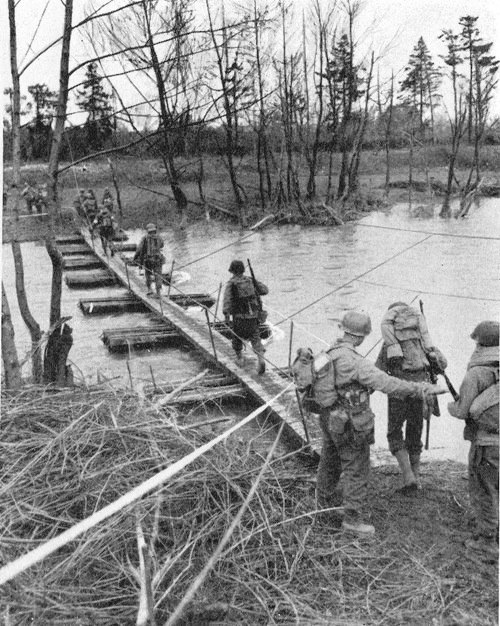
Soldiers of the 1st Infantry Division, with elements of the 1st Medical Battalion cross the Ruhr River on a pontoon bridge.
On 1 April, the Battalion moved 111 miles to Leiberg, Germany as part of the combat operations to close the Ruhr Pocket, where it remained until 6 April. Then followed another series of quick moves; Dahlhausen, Polier, Northeim, Lindau, Schwiegershausen, Sieber and into Stiege in the Harz Mountains. The Weser River was crossed on 9 April, with the outfit finally arriving at Stiege on 16 April. It remained there for only 4 days, before moving to Thale on 20 April. During this period, the Litter Platoons had been constantly assigned to the Battalion Aid Stations, with the Station Platoons handling causalties smoothly in spite of quick moves.
24 April found the Battalion at Ahlsdorf before a further move of 157 miles to Arzberg, Germany on 28 April. This move represented the unit’s last station in Germany.
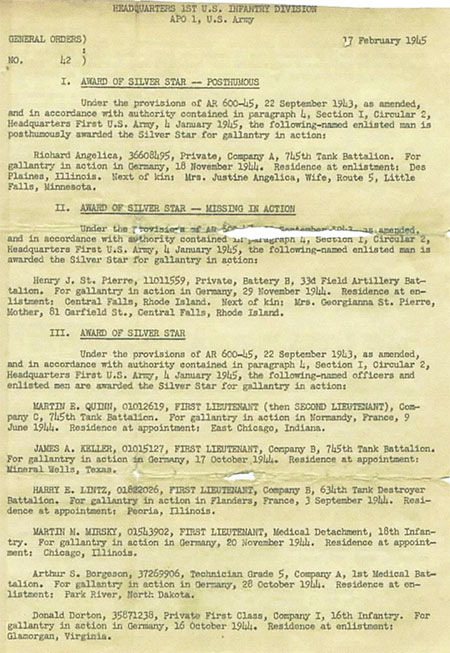
General Orders No. 42, Headquarters, 1st Infantry Division, dated 17 January 1945, detailing the award of Silver Stars to members of the Division.
Czechoslovakia:
On 29 April 1945, orders were received moving the 1st Infantry Division from Germany and into Czechoslovakia. On 1 May, the 1st Medical Battalion had established a CP at Cheb / Eger, Czechoslovakia, where it remained until 5 May before moving to Dol Žandov where it was located when V-E Day was proclaimed. On 7 May 1945 at 1715 hours while at a retreat formation, the Company was read a telegram from SHAEF (Supreme Headquarters Allied Expeditionary Force –ed) announcing the unconditional surrender of all German forces – the war was over! The telegram received was as follows:
“A representative of the German High Command signed the unconditional surrender of all German land, sea and air forces in Europe to AEF and simultaneously to Soviet High Command at 0141 hours Central European Time 7 May 45 under which all forces will cease active operations at 0001 hrs 9 May 1945.”
— SHAEF per Opns Memo, Hq, 1st US Inf Div – 7 May 1945
The End:
Elements of Company B remained at Dol Žandov through the rest of May, resting, checking clothing and equipment, swimming, attending movies and shows. About twenty men from the unit were returned to the Zone of Interior based on their ASR score, with only a few men arriving to replace them. On 9 June, Company B moved to Windsheim Germany, and to Struth the following day where, for the first time since D-Day, it rejoined the 1st Medical Battalion. A light training schedule was initiated and recreation programs were commenced.
Personnel Roster: (incomplete)
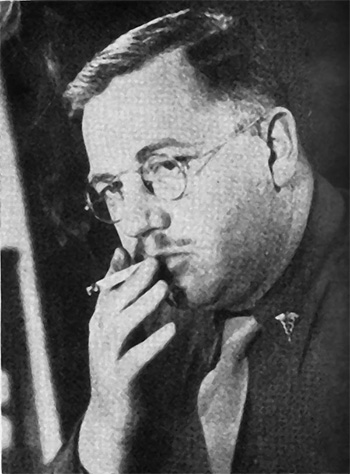
Portrait photograph of Major Charles E. Tegtmeyer, Regimental Surgeon, smoking a cigarette.
| Addison, Glenn R. (Pvt) | Hutchinson, Donald W. (Pvt) |
| Allmoslecher, Adolph A. (Pvt) | Katchur, Michael, Jr. (T/5) |
| Anderson, Harold C. (Pfc) | Lagasse, Real L. (Pvt) |
| Bailey, Paul C. (Pfc) | Lehman, Maurice M. (1st Sgt) |
| Barker, Denver C. (Pfc) | Lenihan, James P. (Pvt) |
| Beals, John (Pvt) | Lewis, Lawrence F. (Pfc) |
| Bedard, Theordore J. (Sgt) | Mailbet, Antoine J. (Sgt) |
| Biles, Robert A. (Capt) | Maloney, John J. (Pfc) |
| Birch, Robert M. (2d Lt) | Mancinho, John (Pvt) |
| Blackwell, Kyle S. (Pfc) | Marcavage, Stanley A. (T/5) |
| Brown, James O. (Capt) | Mason, Charles E. (Pfc) |
| Brown, Renard E. (Cpl) | Mason, George S. (Capt) |
| Camden, Harold B. (Pfc) | McCord, Hugh J. (Pfc) |
| Cappellutti, Frank A. (Sgt) | McFarland, Albert H. (T/5) |
| Carney, James G. (T/5) | McGinty, Owen M. (Pfc) |
| Carten, Clifford G. (Pvt) | Merriman, Philip G. (1st Lt) |
| Caruso, Lawrence J. (Capt) | Miller, Saul (Sgt) |
| Castro, Manuel (Pfc) | Monroe, Maynard L. (1st Sgt) |
| Chiofolo, Joseph T. (Pvt) | Nixon, Marcus R. (Sgt) |
| Chrisafis, James S. (Pvt) | Paris, William (Capt) |
| Cibley, Leonard J (Pvt – KIA) | Pearson, Murble H. (Capt) |
| Conlon, Harold S. (Pfc) | Piasczyk, Chester A. (Pfc) |
| Contorno, Saverio (Pfc) | Pingree, Jack (S/Sgt) |
| Davis, William R. (Pvt) | Poparad, George P. (Pvt) |
| Doherty, William J. (Pvt) | Randall,Lewis E. (Pfc) |
| Dotson, Velden V. (Sgt) | Rickerd, Claud L. (Pfc) |
| Doyle, Arthur P. (Pfc) | Rivera, Genero (Pvt) |
| Dranzo, Nick (T/5) | Romero, Ernesto M. (Pfc) |
| Eleholz, Carl W. (Pvt) | Scalf, Roy (Pvt) |
| Evans, Charles H. (Pfc) | Sherman, Walter A. (S/Sgt) |
| Fanale, John J. (Pvt) | Stadler, Harold E. (Capt) |
| Fawcett, Frank (Cpl) | Sterling, Leonard M. (Pfc) |
| Ficara, Salvatore (Pfc) | Stover, Sanford (Pvt) |
| Fingree, Jack (S/Sgt) | Taylor, Russell H. (Pfc) |
| Frost, James S. (Pvt) | Tegtmeyer, Chartles E. (Capt) |
| Gagne, Alfred R. (Pvt) | Thomas, Harold A. (1st Lt) |
| Gaimari, Alfonso M. (1st Lt) | Towne, Allen N. (Cpl) |
| Gallo, Stephen C. (Pfc) | Traver, Aunger T. (T/4) |
| Gerstenschlager, Delmar L. (Cpl) | Vose, Herald E. (Pvt) |
| Gibson, Roy E. (Pfc) | Waldrop, Ezra K. (Pvt) |
| Gorniak, Joseph, Jr. (2d Lt) | Warres, Herbet L. (1st Lt) |
| Guzik, Lee (Pvt) | Watkins, Archie (Pvt) |
| Hammer, Carl W. (Capt) | Weeks, Ralph S. (S/Sgt) |
| Hennet, Alfred P. (Pvt) | Whitehurst, Grover L. (S/Sgt) |
| Herrick, Charles J (Sgt) | Winchester, Robert (Pvt) |
| Hogan, Ralph J. (Sgt) | Wolf, Raymond E. (Capt) |
| Hosselin, Arthur A. J. (T/5) | Woods, Kenneth K. (Sgt) |
| Huppe, Armand H. (Pfc) | Zimmerman, Albert (Pvt) |
| Hurlhurt, Bernard L. (Pvt) | Zubrick, Michael (1st Sgt) |
Important Timelines – 1st Medical Battalion
Arrived in the Mediterranean Theater of Operations 8 November 1942
Transferred to the European Theater of Operations 20 October 1943
Campaign Credits – 1st Medical Battalion
Algeria-French Morocco, Tunisia, Sicily, Normandy, Northern France, Rhineland, Ardennes-Alsace, Central Europe
It should also be noted that the numerous Companies of the 1st Medical Battalion served different Regiments of the 1st Infantry Division, as follows:
Medical Collecting Company A > mainly attached to the 16th Infantry Regiment and/or 16th RCT
Medical Collecting Company B > attached to the 18th Infantry Regiment and/or 18th RCT
Medical Collecting Company C > attached to the 26th Infantry Regiment and/or 26th RCT
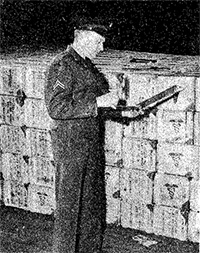
Cpl. Delmar L. Gerstenschlager photographed shortly after the war. Cpl. Gerstenschlager served with Company B, 1st Medical Battalion from 1942 until 1945, when he was transferred to 319th Station Hospital.
The MRC staff would like to extend their most sincere thanks indeed to John Gerstenschlager, cousin of Cpl. Delmar L. Gerstenschlager, who served with the Company B, 1st Medical Battalion from 1942 to 1945. John was able to provide numerous original documents that allowed the editing of this Unit History, and we are forever grateful for his precious assistance. We would also like to thank Pierre Louis Gosselin of the Big Red One Assault Museum, Colleville-sur-Mer, Normandy for kindly allowing use of several period photographs from the Museum’s archives.
